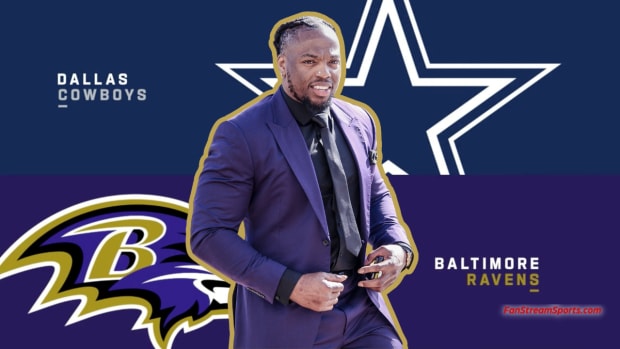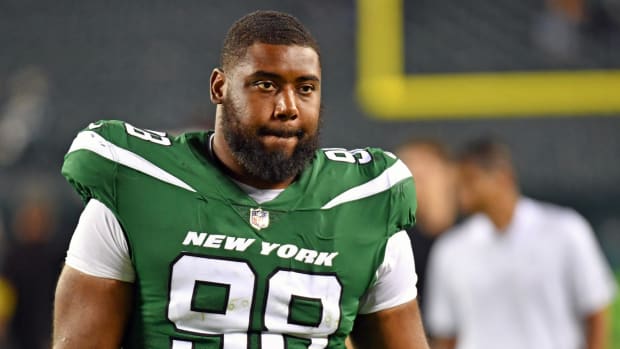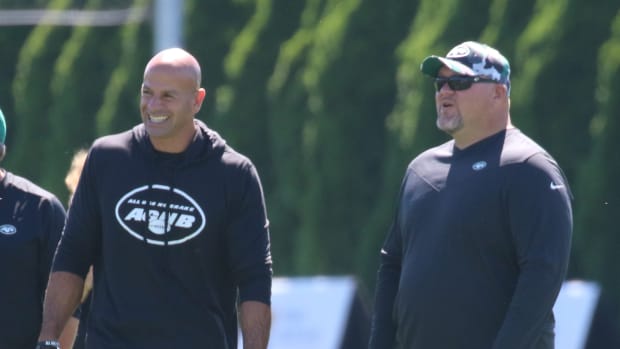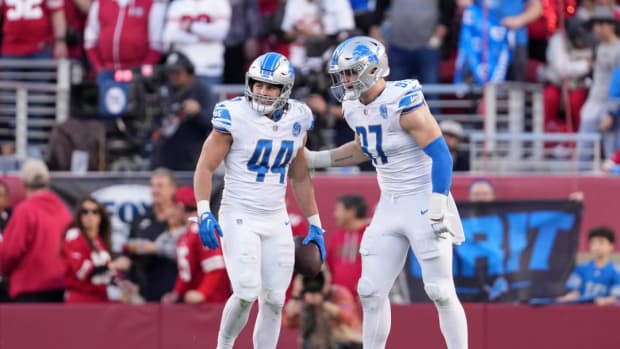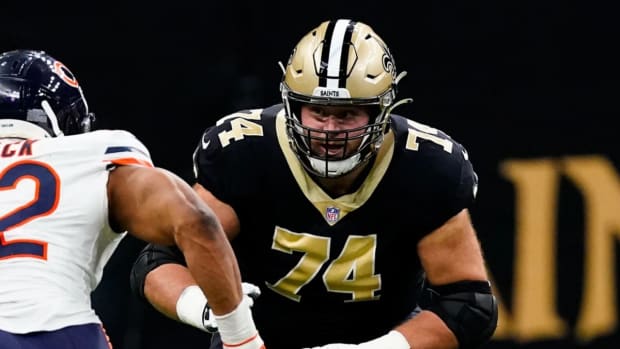One of the most fascinating developments in modern quarterbacking was uncovered in the dark recesses of football Twitter.
There, quarterback junkies search for an edge in video clips, scanning the slow-motion drop-backs, releases and follow-throughs of the best players in the world, trying to identify the mechanical quirks that lead to the most staggeringly beautiful—and stunningly improbable—throws we see every Sunday.
So it was that the Aaron Rodgers Foot Pop came to be known. Some warm-up footage showed the Packers’ quarterback shooting his lead (left) foot in the air for a split second, then touching it quietly back to Earth just after releasing the ball. At full speed it looks like a bit of an Irish step dance; well-timed photographs of Rodgers in action make it seem as if he is levitating as he passes. But the Foot Pop is actually a biomechanical adaptation by Rodgers to, as one quarterbacking expert says, generate a “buildup of rotational force let out in a quicker timeline for explosive power.” If that’s too much to digest, then simply know this: It was something the likes of which we had never seen, and it unlocked Rodgers’s arm talent in ways no one could conceive.
The move went against decades of rigid quarterback instruction demanding that the lead foot be planted securely to ensure an accurate delivery. The Foot Pop even looks different from the traditional throwing motion Rodgers had in 2005, when he entered the NFL. Its effectiveness, however, allowed Green Bay to include imaginative route concepts in its playbook that didn’t exist elsewhere, throws that only Rodgers could make. Study almost any of his biggest passes over the past seven years, and it starts to stand out. After a while it’s like watching a magician so many times that you know how the rabbit is hidden but you can’t help but still be enthralled by the sleight of hand.
“A lot of it was out of necessity,” Rodgers says during a mid-October weeknight drive home from the Packers’ practice facility. “I’ve had a bad knee for 17, 18 years of my life, and it’s forced me to do certain things to offset the pressure on that knee and figure out ways to throw that were pain-free.
“The other part of it was just figuring out how to get ground force when throwing,” he adds, referring to how the Foot Pop launches his throwing motion and allows him to rotate his core faster and farther through his delivery. “And being able to throw from different platforms and weight distributions. [It allows] me to put my hodgepodge of arm angles and weight distribution throws into one and be able to throw from really any platform.”
Rodgers says he often daydreams about adaptations he can make to his mechanics. Sometimes, he finds himself conjuring tweaks while rewatching episodes of The Office, his favorite show.
Will Hewlett, a private quarterback instructor for the football think tank QB Collective as well as a personal coach for Saints rookie Ian Book and Oklahoma star freshman Caleb Williams, popularized the Foot Pop on social media. He tracked the move as it spread first down Green Bay’s depth chart and then through all levels of football and now teaches it to his clients, some of whom have yet to reach high school.
“[Team coaches] were like, ‘Knock that crap off,’ ” Hewlett says. “[I] can’t just say, ‘Well, Aaron Rodgers does it,’ because a coach will say, ‘[He’s] not Aaron Rodgers.’ But how are we going to get another Aaron Rodgers if we don’t let these kids figure this stuff out?”
Those who believe that the recent retirements of Peyton and Eli Manning, Philip Rivers and Drew Brees, plus the imminent departures of Ben Roethlisberger and (maybe, someday) Tom Brady, signal the end of a golden age are missing the almost numbing regularity with which we are seeing better—and far more mind-blowing—throws on NFL Sundays (not to mention college Saturdays and high school Fridays). With the interception rate plummeting, the chance of a turnover on a pass is about the same as a fumble on a run play. The average leaguewide passer rating is about 20% higher than it was in the early 2000s. And the Foot Pop, along with other idiosyncrasies, has gained acceptance. There are now rigorous rehearsals (and a better understanding) of off-platform throws, when a quarterback must move away from the designed launch point of a given play. Those kinds of unstructured moments were once stamped out of a passer by his position coach; now, they could be saving the quarterback species one lifted toe and sidearm sling at a time.
A small sampling from just the first month of the NFL season:
• Kyler Murray, against the Titans, rolls to his right to evade charging pass rusher Harold Landry and splays both of his legs in the air like a shortstop making a throw from the hole to first base. To generate power while aloft, the top half of Murray’s torso twitches as if it were a rotating sprinkler head. His throw traces a path reminiscent of a screwball’s, zipping just beyond a defender and into the outstretched hands of DeAndre Hopkins, meeting the star receiver in stride in the back of the end zone.
• Lamar Jackson takes a shotgun snap on a third-and-4 and immediately steps up into a crowded pocket to avoid Chiefs pass rusher Chris Jones, crashing from the offense’s right side. Jackson sees an open wide receiver but, unable to stride forward in this platform, instead jumps, putting his left hand on the back of an offensive lineman for support, and hooks his throwing arm as if he’s launching a discus. Marquise Brown catches the ball 25 yards down field and trots in for a 42-yard touchdown.
• Patrick Mahomes, facing the Browns, sprints toward the right sideline, his back, right foot stepping on his own 20-yard line. With his left leg elevated, the violence of his throwing motion torques his head so that, just after the release, he’s looking over his left shoulder. The ball travels 50 yards to the Browns’ 30 and into the arms of Tyreek Hill, who runs the rest of the way for a score.
These throws, cultivated on practice fields, tell the story of a gridiron “cultural evolution,” a term scientists use to describe a change that is not genetic in nature but a learned adaptation acquired from other members of the species. Evolutionary experts are just now discovering how various species can adapt and change faster than ever expected. The same can be said for quarterbacks who, after years of stagnancy and groupthink, are opening their minds to achieve stunning results.
“This is a little bit different than how [Charles] Darwin envisioned evolution, which was a slow, gradual change over time,” says Hopi Hoekstra, a world-renowned professor of organismic and evolutionary biology and of molecular and cellular biology at Harvard. “We definitely know that evolution can act in a burst.”
Think of quarterback as its own species, and consider how hellish its natural habitat has become over the past three decades. There used to be only one Lawrence Taylor, a speed pass rusher who could not be contained by a single blocker—now there’s at least one on almost every team. Defensive backs have gotten taller and faster. Defensive tackles are 35 pounds heavier on average but run the 40 in times that compare favorably with old-school wide receivers’. The pocket, the quarterback’s oasis, has become a feeding ground for apex predators.
Before a series of beautiful and strange circumstances brought the likes of Rodgers, Russell Wilson, Dak Prescott, Mahomes, Josh Allen, Jackson, Murray and Justin Herbert into the football world, the species was threatened. A growing mediocrity had taken hold, with a few well-coached, archetypal pocket passers fighting back a wave of new defenses that threatened to reprise the touchdown-scarce NFL of the 1960s and ’70s.
In the wild, circumstances like these are how a species either reaches extinction or avoids that fate by evolving. “It’s like Jurassic Park—life finds a way, right?” says Shane Campbell-Staton, an assistant professor of evolutionary biology at Princeton. “At the same time, some species are going extinct. They are. But that is also part of evolutionary change.”
Campbell-Staton has studied the effect of urbanization on the anole lizard in Puerto Rico and the surge of tuskless female elephants emerging in central Mozambique following the civil war. His work has centered on the phenomenon that as the human race hurls curveballs at the plants, fish, birds, insects and mammals in this world, some find a way to overcome in a matter of a few short years.
The lizards in Puerto Rico? They ventured into the heat of big cities and, over the course of a generation, sprouted longer limbs to adapt to the flat, smooth surfaces. They grew larger toe pads so they could better cling to concrete and metal. They got noticeably faster than their forest counterparts to avoid humans and cars racing through streets.
The elephants of southeast Africa? In just a single generation, those that survived the country’s brutal 15-year conflict, ending in the early 1990s, began producing female offspring with no tusks at a rate of 33.0%, as opposed to 18.5%. This was a response to poachers’ increased hunting and killing elephants for their ivory to purchase arms and other supplies for the war.
Around the start of the century, quarterbacks were dealing with their own man-made challenges to survival. Not only did faster defenders mean fiercer pass rushes, but the throwing lanes also became narrower and closed more quickly; smarter defenses exposed offensive predictability; and the increased availability of film allowed opponents to pick apart a quarterback’s tendencies and tailor schemes to exploit his weaknesses. Meanwhile, the quarterbacks’ coaches were getting older and more stubborn.
“Quarterbacks have to evolve,” says John Beck, a former NFL quarterback who trains Zach Wilson, Matt Ryan and Trey Lance, among others, and is currently on contract as a consultant with the Jets. “Look what defenses can do. Pass rushes. Coverage. Everyone tries to use all their weapons. Athleticism is one of those weapons. Everyone is going to use it. So the quarterback cannot stay the same.”
The reasons they became quarterbacks were largely homogeneous as well—a poorly kept secret. Quarterbacks had to be the right size, throw the right way, play in the right offense and somehow survive the massive collegiate filtration process before making it to the draft. Many talented quarterbacks at lower levels were moved off the position as they neared the pros, lessening the talent pool.
Rodgers’s mastery of the NFL, which bloomed over the course of a decade, caused some at the highest levels of the game to rethink how they identify and groom the position. The emergence of Mahomes, Allen, Murray and other brilliant young passers who are as comfortable and accurate on the move as they are in a padless game of soft toss, toppled the barriers altogether.
Mahomes, like Rodgers, ushered in a new maneuver. It comes on run-pass option (RPO) plays, when the quarterback takes a shotgun snap and presents the ball for a handoff while reading a defender at the linebacker level; if that defender plays the run, the QB pulls the ball back and throws instead. Quarterbacks passing in an RPO used to reset their frame completely to use a traditional motion and mechanics. Mahomes, however, began making RPO throws with his feet still set up for a handoff, rather than targeted toward the receiver, so that he could get the ball out much faster. Like the Foot Pop, it has become ubiquitous in the NFL.
The quarterback species now had its cultural equivalent to larger toe pads and longer limbs to pass on to future members. Around them, an infrastructure of coaches, agents, trainers and parents began to grapple with the questions necessary to hone the skills for throws that could, regardless of the defense and coverage, still result in a 40-yard touchdown.
What if we let our best athlete play quarterback?
What if we welcomed the volatility that might come along with that?
What if we tried to better understand on-field chaos and found a way to practice it?
What if we questioned the existing knowledge?
“What would have happened if Patrick Mahomes had modeled his game completely after Peyton Manning?” asks Bobby Stroupe, a health, performance and player development coach who works with the K.C. quarterback. “If he tried to stand on his tippy toes and dance around and throw the ball down like a dart, would you even know his name?”
Mahomes rotates his spine at 240 degrees per millisecond and has moving head control reminiscent of a Northern saw-whet owl—facts you do not need to know but ones Mahomes knows about himself. They help inform the independent training program that he goes through with Stroupe, six hours a week during the season and 12 to 15 hours a week during the offseason. This preparation, in turn, allows Mahomes to pull a mental ripcord during a play and execute a feat of quarterbacking wonderment.
His case seems to represent a fascinating divide in the recent evolutionary development of quarterbacks. Almost all the new wave of QB coaches agree on the basic tenets: controlled experimentation (let the kids play like kids and see what happens, then help them develop a solid foundational base) and a less cemented idea of what fundamentals are (don’t immediately call someone undisciplined for throwing off-platform or from a different arm angle, but work toward it, or work with it). But the approaches to their instruction are disparate.
Mahomes’s natural gifts are molded in a process called “movement literacy,” which takes his skills and chisels them through practical actions that are, essentially, pared-down versions of the kinds of steps, jukes and sprints he would need to make during a game. He spends time skipping on one leg while walking on the other. From years of training, he sprints backward almost as fast as he sprints forward. He runs in curvilinear patterns. On a strip of padded track he does both symmetrical and asymmetrical shuffles, steps and skips while dealing with different variables (anything from balancing a tennis ball on the top of his hand to throwing a football). These exercises bolster his inherent ability to sprint out of the pocket, open his hips and launch a cross-body pass the length of the field.
Mahomes works on intensely microscopic ankle and foot balance drills, which help his body find a certain homeostasis when, for example, he launches one of his trademark unbalanced RPO throws. The result, Stroupe says, is “an ability to express himself creatively through the quarterback position, which is a really beautiful thing.”
Depending on which high-profile quarterback trainer you talk to about the flood of dazzling passes and polished quarterback play, you get a different snapshot of the landscape.
• In Orange County, Calif., former NFL quarterback Jordan Palmer, who trains Allen, Joe Burrow, Sam Darnold and Trevor Lawrence, among others, tries to first create biomechanically sound “consistent movement patterns” that can aid a quarterback in finding constant equilibrium regardless of whether he has two feet or just one toe touching the ground, not unlike what Stroupe wants for Mahomes.
Then, Palmer will run an exercise in which receivers of different ages and skill levels are positioned out wide. (The age part is key, he says, because it forces quarterbacks to learn to judge speeds and angles instantaneously; some of the pass catchers are only in eighth grade.) The passer will drop back into a footwork drill, chopping his feet, for example, through a rope ladder on the ground. Meanwhile, one of the receivers will take off and flash a sign that indicates one of three different throw strengths needed: a hard, driving pass; a medium-range pass; or a floating touch pass. At the same time the quarterback must deal with some kind of chaos enveloping his lower body—for instance, stepping through an agility ladder—simulating a muddy pocket. He has to focus less on what routes should look like and where the ball should be, and more on turning himself into a central processing unit that can react to anything. This makes potentially improbable throws feel almost routine.
“Quarterbacks don’t make decisions before we call the play,” Palmer says. “[They] make visual decisions.”
The perfect example, Palmer says, came in a game between the Jets and the 49ers a year ago. Darnold ripped himself away from San Francisco defensive tackle Kevin Givens, who was pulling on the quarterback’s jersey, trying to drag him down. After nearly tumbling during the escape, which caused him to cradle the ball like a fullback bracing for contact, Darnold righted his stance, shuffled to his left, and, while his body spun backward in a clockwise direction, hooked a curveball-shaped pass to receiver Braxton Berrios, who caught the ball and ran untouched for a score.
• In Atlanta, Sean McEvoy, a trainer with QB Takeover, a firm that works with Deshaun Watson, Jalen Hurts, Justin Fields, Tyrod Taylor and potential 2021 first-round pick Malik Willis of Liberty, runs drills that simulate the evasion of a defender, escape to the sideline and eventual off-platform throw. The field is dotted with cones that prompt the quarterback to drop back, sprint shuffle to his blind side, sprint in the other direction, then spin back toward the blind side, until he releases a throw from a potentially vulnerable, unset position. Willis completed a pass comically similar to the path taken in this drill against Virginia Tech a year ago.
McEvoy, like all his peers, stresses that traditional fundamental training is still a prerequisite—the basic mechanics must be routine before experimenting—but “by the time these kids get to high school, you can really push the boundaries of what they’re able to do. Now, you’re trying to get them consistent in the craziest throws out there, the craziest situations that may come up.”
• In Fort Lauderdale, Lamar Jackson’s personal coach, Joshua Harris, wields a broom during practice and swings it at his future $40-plus-million-a-year client while he drops back in the pocket to pass. The pair have been working together since Jackson was at Louisville, and Harris has grown adept at frustrating Jackson with the cleaning tool, making a whoooosh sound that reverberates in Jackson’s ear before he throws the ball.
Harris says that over the last year, roughly a third of their practice time has become devoted to making off-platform throws or nontraditional arm slots, expanding from a five- or 10-minute period at the beginning of their working relationship.
“It’s recognizing the reality of the position,” Harris says. “We’ve lived in this false narrative for so long of, ‘Get your feet like this.’ Well, it’s never really like that. The pocket is never really clean at any level of football.”
Harris admits to shaking his “herd mentality” when he saw Jackson unleash his own beautiful anomaly in NFL games, a sidearm pass that hooks around defenders like a free kick in soccer. In a January divisional playoff game against the Titans, Jackson used it to gain a first down despite being enveloped by a mass of bodies in the pocket, bending the ball around the helmet of an offensive lineman.
He didn’t think much of it when he saw Jackson make that throw the first time, because he was playing with children. Jackson, who allows kids to approach him during training sessions and throw the ball around, began twirling passes from absurd arm angles while maintaining a foundational base with his lower half. Harris’s fear that he risked becoming the man who ruined Lamar Jackson began to dissipate as he designed practice routines that included the sidearm throws, along with a new credo for training the NFL’s most fascinating quarterback.
“Yo, does it work?” Harris asks. “If it works, let’s do it.”
About 10 years ago, Hoekstra, the Harvard professor, traveled to the sand hills and alfalfa farms of northwestern Nebraska along with a small team led by then postdoctoral fellow Rowan Barrett to see evolution in real time.
Their experiment would draw from the theory of Darwin, the father of evolutionary biology, that we, as a species, can adapt and change over generations because of our changing environment. We can evolve through natural selection.
Scientists believe that 10,000 years ago, deer mice had dark fur. As Nebraskan sand hills formed, so did a mutation that created lighter pigmentation for fur. The split, and the breeding of lighter mice on the sand hills, allowed the population to thrive.
The researchers hauled in tens of thousands of pounds of steel plates, slotting them either into earthy brown soil or brighter, sandy terrain to formulate eight quarter-acre enclosures that would each house about 100 field mice, approximately half of which were dark brown and half of which were tan. As expected, the dark mice were eviscerated by hawks and owls on the sandy terrain, just as the lighter mice were targeted on dark soil because their color stood out. The ones whose fur color matched their environment stood a better chance to survive: natural selection in a nutshell.
After some DNA sequencing, the team discovered that, over the course of just a few generations, each enclosure’s surviving mice had better equipped their children for a long life in their new habitat. The remaining dark mice were more likely to carry a gene that aided in the production of a dark pigment to their fur. The lighter mice surviving had a different copy of the gene that would make their fur lighter.
“It provides more concrete evidence of evolution and it does make you think about, like humans, we are the product of this same exact process,” Hoekstra says.
“I don’t think about that on a day-to-day basis but every now and then I’ll think, Wow, we ended up here through this process. A little bit of chance, more or less random mutations appear, and every once in a while you get something that’s beneficial that gets swept through the population.”
Hoekstra, Barrett and their team were able to show that, rather than over thousands of years, this evolution could occur—in this case—over just three months. That predators will not necessarily cause extinction. That, faced with mortal threats, something innate can drive a species toward a better future.
The next generation can be harder to hunt.
At his Pro Day last spring, one month before he became the draft’s No. 2 pick, Zach Wilson faked a wide handoff to his right and began a deep, looping bootleg to his left that served as the preamble to the marquee throw of his showcase.
When his right, back heel brushed the left hash mark of the 36-yard line, 10 yards behind the original line of scrimmage, he made a short hop while reversing his lower body until his legs formed an almost perfect Y shape. It was a vulnerable position, one that seemed to provide almost no foundation for a standard throw. Yet, there was Wilson, with both feet elevated off the ground as he whipped the ball 45 yards to the right, against the momentum of his body, hitting his receiver perfectly in stride.
The play caused the announcers broadcasting the event to stop mid-sentence. A whooping sound, not unlike the rallying cry of professional wrestler Ric Flair, broke the silence inside BYU’s field house as Wilson cemented his position as the No. 2 pick in the draft.
“He did that, and then this is how quickly things move: Other quarterbacks started putting the throw into their pro days,” BYU coach Kalani Sitake says. “Even my kid went out into the backyard and was trying to do it.”
It was a Rodgers Foot Pop, one of the clearest examples that the move had been passed down to the next generation. Beck, who trains Wilson and, as a player, trained with Rodgers, was the link.
“I had the opportunity to be around Aaron a lot, be with a lot of the guys that were with Aaron on the Packers, so you got to hear why he does what he does,” Beck says. “He told it to the guys he would train with. Then we train a bunch of those guys. So, Zach wasn’t just seeing it and trying to replicate it; it was actually knowing why Rodgers does what he does.”
After Wilson’s throw went viral McEvoy received a text from one of his students who said that the pass reminded him of a drill they did regularly. McEvoy’s student starts for a high school junior varsity team.
This once exceptional mechanical tweak was almost commonplace in the wild now. Hewlett smiled as he watched Caleb Williams, the first true freshman to start for Oklahoma in three decades, break out a pair of Foot Pops during a stunning 52–31 debut victory over TCU in mid-October, when the 18-year-old threw for four touchdowns.
Quarterback trainers can point you to their favorite YouTube compilations of freckle-faced preteens launching 30-yard, tight-spiraled bombs, despite barely being able to sustain the weight of the helmet resting on their tiny shoulders. Instagram is littered with slow-motion Foot Pops, as omnipresent among the high school football social media crowd as any TikTok dance.
On his drive home from practice, Rodgers reflects on when he entered the league and what the QB species looked like then. He pulled what he could from his favorite nonconformists like Steve Young and Randall Cunningham, players who, he says, “bucked the system.”
Survival, to Rodgers, meant being completely unafraid to experiment with all he knew. Now, he says it’s surreal to see “things I’ve been a part of that have gone around the league; things I came up with at my house, a thought in the middle of the night, are now concepts in every offense.”
Around him, life found a way.
“I was one of the outliers,” Rodgers says. “Now, it’s totally flipped.”
Read more of SI's Daily Cover stories here:
• How the Defense Became the Packers’ New MVP
• How Does Dan Campbell Create a Winning Culture While Losing?
• How Steelers' Logo Helped Heal Pittsburgh After Synagogue Shooting
• The Mystery and Controversy of the Original Rams Helmet





































